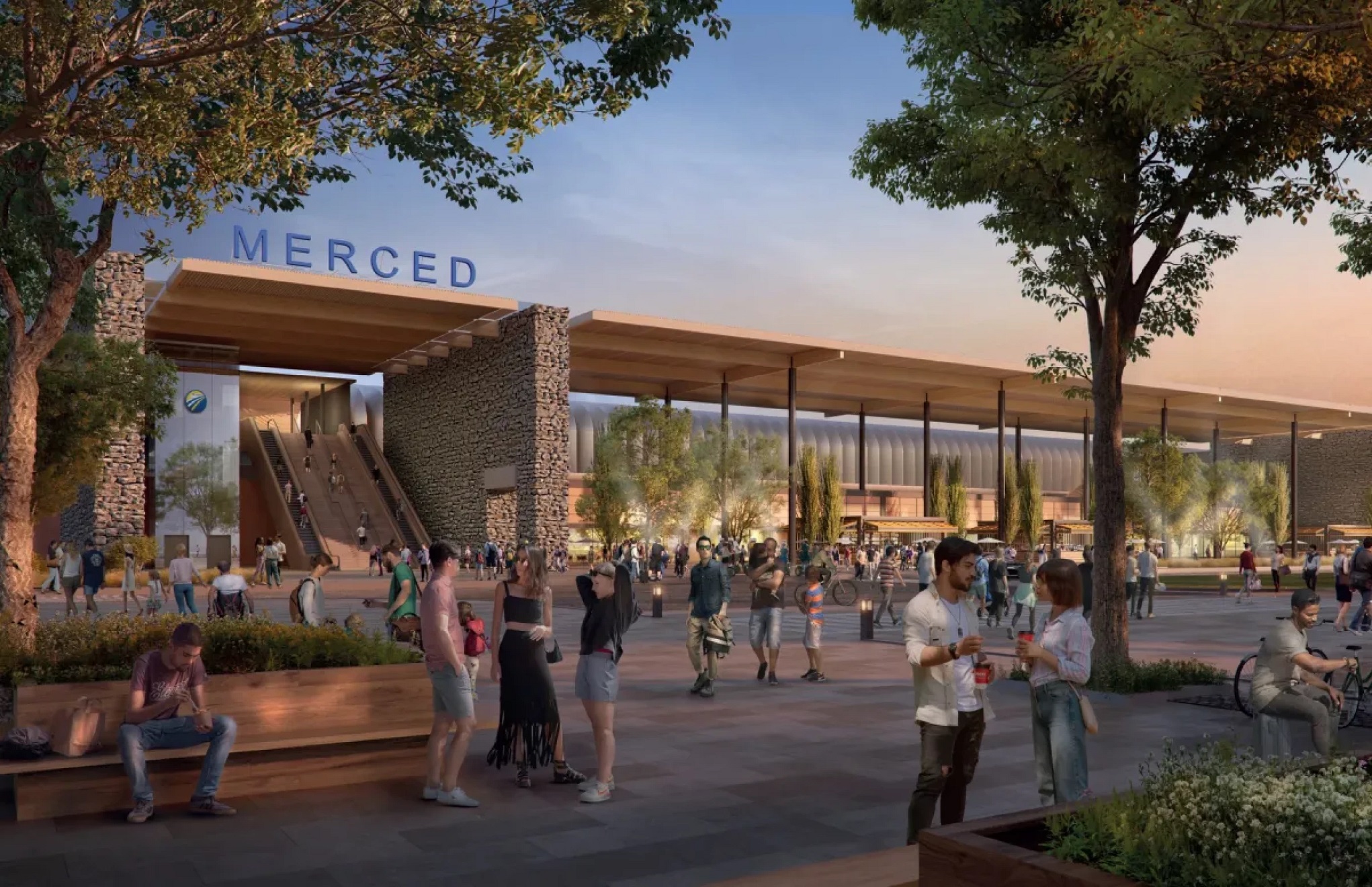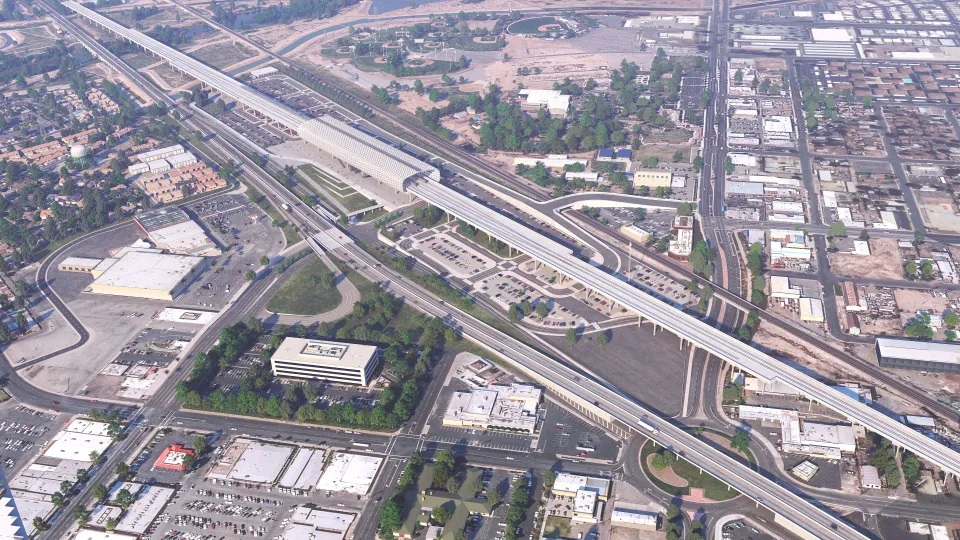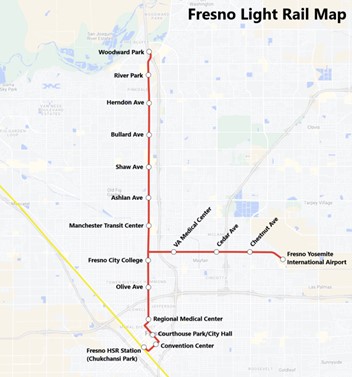Passenger Rail/Transit/Land Use Working Group

A primary outcome of the October 9-10, 2023, SJV Planning Directors’ Committee Retreat was the formation of the “Passenger Rail/Transit/ Land Use Working Group” (Working Group) to serve the San Joaquin Valley Regional Policy Council (SJV RPC). The purpose of this Working Group is to develop, promote, and help implement a vision for passenger rail, transit, and land use around public transportation (transit-oriented development) in the San Joaquin Valley. As the construction of our nation’s first 200+ mile per hour high-speed rail (HSR) system moves forward in the San Joaquin Valley there is a tremendous opportunity to improve public transportation and implement more transit-oriented development (or TOD) throughout the San Joaquin Valley.
The Working Group is led by the San Joaquin Joint Powers Authority (SJJPA) staff. Each of the eight San Joaquin Valley Regional Transportation Planning Authorities (San Joaquin Council of Governments, Stanislaus Council of Governments, Merced County Association of Governments, Madera County Transportation Commission, Fresno Council of Governments, Kings County Association of Governments, Tulare County Association of Governments, and Kern Council of Governments) have assigned at least one senior staff member to this Working Group. Meetings are typically held bi-monthly, but the Working Group can meet more frequently as needed.
Key activities and accomplishments of this Working Group include:
Vision Documents
In partnership with the California High-Speed Rail Authority (CHSRA), the Working Group has produced the Vision for Integrated Passenger Rail/Transit in the San Joaquin Valley handout. This important document shows and describes an integrated passenger rail and transit network envisioned to connect HSR to communities throughout the San Joaquin Valley and California. The one-page (two sided) handout will be included as part of the SJV RPC annual lobby efforts in both Sacramento and Washington DC. This valleywide handout is also used by SJV RPC members and CHSRA to help convey and promote the ambitious and transformational rail/transit network under development in the San Joaquin Valley. In addition, the Working Group in partnership with CHSRA developed county-level handouts for each of the eight San Joaquin Valley counties to provide greater details for the envisioned passenger rail/transit and highlight areas within each county where transit-oriented development will be a focus for local communities. The county-level handouts can be downloaded from this listing: San Joaquin, Stanislaus, Merced, Madera, Fresno, Kings, Tulare, and Kern. The Working Group greatly appreciates CHSRA for partnering on both the valley-wide and county-level handouts and providing the resources needed to create these key deliverables.
San Joaquin Valley Network Integration and Transit-Oriented Development Action Plan (Plan)
One of the first efforts of the Working Group was to develop and submit a Caltrans Sustainable Transportation Planning Grant application to support the efforts of this new Working Group. With the support of the Working Group, SJV RPC, SJV Planning Directors’ Committee, and numerous other partner agencies and organizations in the San Joaquin Valley, SJJPA applied to Caltrans for the “San Joaquin Valley Network Integration and Transit-Oriented Development Action Plan (Plan)”. SJJPA received notification in July 2024 of a successful award and anticipates initial work for the Plan to begin during the summer of 2025.
SJJPA will lead the San Joaquin Valley Network Integration and Transit-Oriented Development Action Plan (Plan), and work together with the Working Group, CHSRA, and the California Department of Transportation (Caltrans) on its development and production. The Plan will develop expanded connectivity options between High-Speed Rail’s (HSR) Bakersfield to Merced segment, Altamont Corridor Express (ACE) commuter rail service and San Joaquins

intercity passenger rail service along the new “Valley Rail” corridor in the San Joaquin Valley, the Cross-Valley Corridor, Valley Link, and other existing and planned transit and passenger rail services within the San Joaquin Valley. The convergence of HSR, ACE, San Joaquins, Valley Link and Cross Valley Corridor services present the San Joaquin Valley with an opportunity to integrate with other planned services, yet no uniform effort has been made to ensure that these services support multimodal, multi-service trips. The goals for the study consist of identifying existing and future rail and transit improvements in the San Joaquin Valley and gaps where further rail and transit coordination and investment is needed to integrate local and regional transit systems with expanding intercity and High-Speed passenger rail services as they are implemented.
The Plan is intended to improve transit performance by also supporting station-area development and TOD strategies in the San Joaquin Valley. Land use strategies and recommendations will be compatible with State and Regional sustainability goals, transit-supportive land uses, station-area development, reducing sprawl, reducing greenhouse gas emissions, improving overall air quality, and promoting TOD surrounding and associated with the planning area, building on the principles and guidance set forth by the Caltrans Smart Mobility Framework, Complete Streets Strategies, Climate Action Plan for Transportation Infrastructure (CAPTI), California State Rail Plan, and California Transportation Plan (CTP) 2050.
The Plan involves engaging underserved communities to develop transportation and land use recommendations, reduce transportation barriers, and increasing regional mobility options for the San Joaquin Valley.


The development of the Plan will offer opportunities for underserved residents, Native American Tribal Governments, and rural communities in the region to provide input and guide the Plan’s development through in-person and virtual community workshops, surveys, and other interactive planning activities. Working alongside experienced consultants, SJJPA will:
- Identify and engage with established community-based organizations that mobilize underserved communities to establish collaborative relationships.
- Involve local health departments, which can aid in reaching community-based organizations and underserved community members.
- Engage in partnerships with marginalized and underserved communities to co-create and execute principles that will guide the development of the Plan to address their specific needs and challenges.
- Create opportunities for input accessible virtual workshops online through the Plan website and through virtual public meetings.
- Translate project materials in regionally significant languages, facilitating the accessibility of input efforts to all communities in the region.
- Engagement and updates will continue to be available on the Plan website throughout the duration of this planning initiative and the implementation of resulting Plan projects.
The Plan will contribute to the State’s greenhouse gas (GHG) reduction targets and advances transportation related GHG reduction strategies by:
- Creating opportunities for TOD by identifying complementary land use opportunity areas and improving network connectivity. The plan aims to create a buffer around stations, service lines, and other significant passenger rail and transit service stops, establish density ranges, and identify prospects for affordable housing. These measures are designed to encourage mode shift and decrease VMT on the State Highway System – including I-5, I-205, I-580, SR 99, SR 41, SR 43, SR 120, SR 132, SR 140, SR 180, and SR 198 – by enhancing multimodal access.
- Creating multimodal opportunities to connect residents and visitors between these transportation services to employment and retail centers. This consolidated planning effort will result in an extensive network of alternative routes to destinations throughout the rest of the region. Residents will connect between the existing and future passenger rail and transit services and new multimodal improvements.
- Reducing urban sprawl by discouraging leap-frog development and incentivizing smart growth. This type of development reduces VMT by creating a phased plan for development rather than being led by developers’ interests. This will ensure land uses are synchronized with the proposed transportation system and station areas and improve overall transit performance for residents throughout the San Joaquin Valley.
- Advancing regional transit connectivity between the San Joaquin Valley and beyond through a supplemental planning study that prioritizes short-, mid-, and long-term strategies.
Implementing the Plan will have many expected benefits for the San Joaquin Valley, including:
- Sustainability: Reduce VMT, improve air quality, and preserve the State’s natural lands by supporting increased use of public transportation and smart development, as well as reducing the impacts of inefficient land use.
- Preservation: Preserve the transportation system by identifying key infrastructure and service improvements, encouraging TOD and multi-modal connectivity, and promoting consistency between transportation improvements and local growth patterns identified at all planning levels.
- Accessibility: Identify multimodal transportation opportunities, improve regional transit performance, and identify infrastructure needs for school-age children, older adults, and people with disabilities.
- Safety: Substantially reduce fatal and serious injury crashes by incentivizing the safe use of roadways, aligning with the Safe System approach, and shifting vehicle users to public transportation.
- Economy: Facilitate economic vitality and identify land dedicated to transportation infrastructure and residential land use. Connections with HSR and existing and future passenger rail services will facilitate regional access to employment and destinations throughout the State, supporting greater regional economic growth.
- Health: Enhance active transportation, reduce VMT, and improve air quality by encouraging physical activity and enhance health outcomes.
- Social Equity: Seek feedback on transportation solutions from underserved communities and will prepare high-level guidance for San Joaquin localities. The feedback will inform the identification of affordable housing near key destinations and result in an Equity and Displacement list of best practices.
The Plan will carefully examine opportunities for connectivity along the upcoming HSR, current passenger rail, and transit services. It will also incorporate land-use suggestions that align with these modes and support compatible station-area development. The Plan includes ongoing involvement


with underserved communities and the Working Group to formulate transportation and land-use recommendations. By identifying existing and future service and infrastructure improvements while involving community and Working Group stakeholders, the Plan can prioritize these improvements and match identified projects with funding.
Valley Voice Support for Sacramento and DC Lobby Days
Passenger Rail and Transit are key elements of the platforms for the SJV RPC’s Valley Voice annual lobby efforts in Sacramento and Washington DC. The Working Group played an important role in helping to develop, review, and approve the SJV RPC’s platforms for Passenger Rail and Transit for both the Sacramento and Washington DC Valley Voice 2024 trips.
San Joaquin Valley Passenger Rail, Transit, and Land Use Planning Studies led by Partner Agencies
An important role of the Working Group is to provide support to Member Agencies and other San Joaquin Valley agencies to secure funding and carry out planning studies that promote expanding and improving passenger rail, transit, and transit-oriented development in the San Joaquin Valley. These planning efforts are guided by the Caltrans Smart Mobility Framework, Complete Streets Strategies, Climate Action Plan for Transportation Infrastructure (CAPTI), California State Rail Plan, and other design and policy principles.
Key planning efforts underway in the San Joaquin Valley supported by the Working Group include:
- Madera Station Transit Area Specific Plan Project: Madera County, in partnership with the City of Madera, Madera County Transportation Commission, CHSRA, Caltrans, SJJPA and other stakeholders, is undertaking station area planning in an area east of Highway 99 along Avenue 12, about 5 miles southeast of the City of Madera and adjacent to the Madera Campus of the State Center Community College District. This project will result in the creation of a Transit Area Specific Plan and inform the phased implementation effort to relocate the San Joaquin Madera Station and construct the adjacent future High-Speed Rail station. This will lead to the creation of new intermodal transit options and future transit-oriented development along the Avenue 12 corridor in southeastern Madera County. The planning effort will guide the design and land-use in the vicinity of the station area as well as enable Madera County to promote economic development, encourage station area development, and enhance multi-modal access between the station, the City of Madera, Madera Community College, and other surrounding communities throughout Madera County and northern Fresno County. For more information regarding the Transit Area Specific Plan effort, please visit the Madera County webpage: https://www.maderacounty.com/government/community-economic-development-department/divisions/planning-division/madera-transit-station-specific-plan.

- Downtown Stockton Multimodal Transportation Network and Land Use Compatibility Action Plan: The City of Stockton, in partnership with San Joaquin Council of Governments (SJ COG), Caltrans, the San Joaquin Regional Rail Commission (SJRRC), the SJJPA, and the San Joaquin Regional Transit District (RTD), have started a planning project that will build on the Valley Rail Expansion Program efforts to integrate the future rail network and its operations with the Cabral Station, Downtown Transit Center, and surrounding transportation network and land use within Downtown Stockton. Disadvantaged communities will be directly engaged to identify infrastructure and programmatic recommendations to build cohesion between the future multimodal transportation network and proposed land uses that are transit-supportive and adapted for Downtown Stockton. The existing project area lacks cohesion between land use and infrastructure and requires planning and investment to prioritize and encourage revitalization, consistent with the implementation of Valley Rail. The goal is to develop a safe and vibrant community that encourages infill growth, reduces vehicle ownership reliance, and promotes walking and biking between local and regional transit services. For more information contact Jordan Peterson at Peterson@stocktonca.gov.
- Lodi Multimodal Transportation Network and Land Use Compatibility Action Plan: In partnership with SJ COG, San Joaquin Regional Rail Commission and the San Joaquin Joint Powers Authority, the City of Lodi is preparing the Lodi Multimodal Transportation Network and Land Use Compatibility Action Plan (Plan). The Plan will identify current and future rail systems, multimodal networks, and increased connectivity and developmental land usage within the Plan scope area that includes the existing Downtown Lodi Station and the future Lodi Valley Rail Station that will be located along Avenue 12 to the west of Lodi. This effort will involve directly engaging underserved communities regarding employment access, housing and business opportunities, cost-effective travel for non-vehicle owners, bicycle, and pedestrian facilities, and expanding regional transportation services. Plan development will expand local and regional connectivity, support the economic development of downtown Lodi and wine tourism, and encourage residents to utilize multimodal travel options for regional commutes to work and recreation. For more information contact Julia Tyack at jtyack@lodi.gov.

- Kings-Tulare High-Speed Rail Station Transit-Oriented Development and Connectivity Plan and Cross Valley Corridor Rail Service Planning: In collaboration with in-kind contributing partners, this project will build upon planning efforts for the Kings-Tulare High-Speed Rail (HSR) Station and Cross Valley Corridor (CVC) to identify recommendations for connecting transit services between Downtown Hanford and the Kings-Tulare HSR Station along Lacey Boulevard, and promote transit-oriented development (TOD) around the Kings-Tulare HSR Station. This Project will coordinate efforts of the City’s General Plan, Kings County Association of Government’s 2022 Regional Transportation Plan Sustainable Communities Strategy, and the Cross-Valley Corridor Plan. The final plan will guide land use planning along Lacey Boulevard and the Kings-Tulare HSR Station, support TOD, promote economic development and revitalization, enhance connections to transit and mobility choice, stimulate connectivity between Downtown Hanford and the Kings-Tulare Station, connect Hanford with other communities along the CVC, and support an efficient and effective multi-modal transportation system in some of California’s most disadvantaged and low-income communities. For more information, please visit the City of Hanford’s webpage for this project: https://www.ci.hanford.ca.us/1580/Kings-Tulare-High-Speed-Rail-Station-Tra.
- Fresno County Regional Rail Feasibility Study: Fresno COG is leading this planning effort to study the feasibility of a zero-emission regional rail system in Fresno County, primarily connecting the communities of Fresno, Firebaugh, Kerman, Mendota, Reedley, San Joaquin, Fowler, Selma, Kingsburg, and Sanger, as well as the Tulare County community of Dinuba which is just over the Fresno-Tulare County border from Reedley. The study includes an analysis of zero emission vehicle technology and operational capability for this rail system without any greenhouse gas emissions or air pollutants. Ridership modeling will help determine feasibility of the rail system, and the study will evaluate a phased implementation approach if it is demonstrated that a regional rail system is viable from a ridership and operational cost perspective. This study aims to plan for connectivity and accessibility of sustainable, quality transportation for underserved communities. For more information contact Paul Herman at pherman@fresnocog.org.
The Working Group is pleased to report that Fresno COG and the City of Modesto were successful in securing Sustainable Transportation Planning Grants from Caltrans for FY 2025-26 that were supported by the Working Group. These two efforts are expected to be initiated in 2026:
- Fresno Light Rail Feasibility Study: Fresno COG was awarded $700,000 by Caltrans to complete a case study for the feasibility of Light Rail Transit (LRT) in the Fresno Metropolitan Area. There is a strong overall travel demand into downtown Fresno and adjacent areas, with the potential to shift many of these trips to public transit. The study will evaluate the economic, social, and environmental benefits for the Fresno area. Options to be assessed will include LRT, Streetcars, and other light rail options. Ridership modeling will be done to help determine feasibility of the LRT system, with the study evaluating a phased implementation approach if it is demonstrated that an LRT system is viable from a ridership and operational cost perspective. This study aims to plan for connectivity and accessibility of sustainable, quality transportation for underserved communities. For more information contact Paul Herman at pherman@fresnocog.org.

- Downtown Modesto Multimodal Transportation Network and Land Use Compatibility Action Plan: The City of Modesto was awarded $450,000 by Caltrans for the preparation of the Downtown Modesto Multimodal Transportation Network and Land Use Compatibility Action Plan (Plan). The proposed Plan will build on the efforts of SJRRC’s Valley Rail Project to seamlessly integrate the future rail network and its operations with the new Altamont Corridor Express (ACE) commuter rail station. In collaboration with multiple partner agencies and stakeholders, including direct engagement with local underserved communities, the City will focus Plan development on expanding regional access, encouraging infill development, and encouraging residents to utilize multimodal travel options. These improvements will also support multimodal trips to many key destinations within the City and region. For more information contact Jessica Hill at jhill@modestogov.com.

